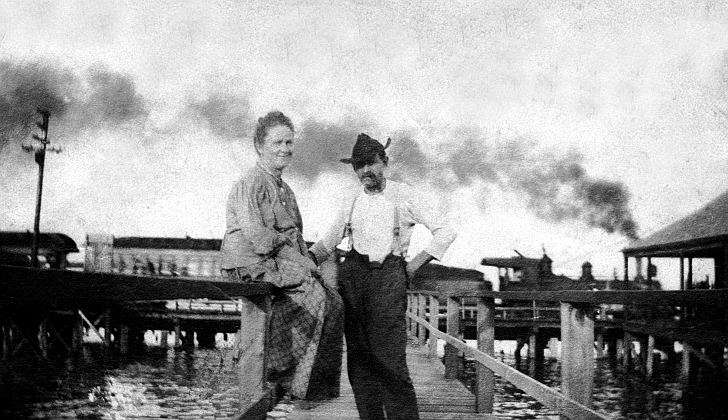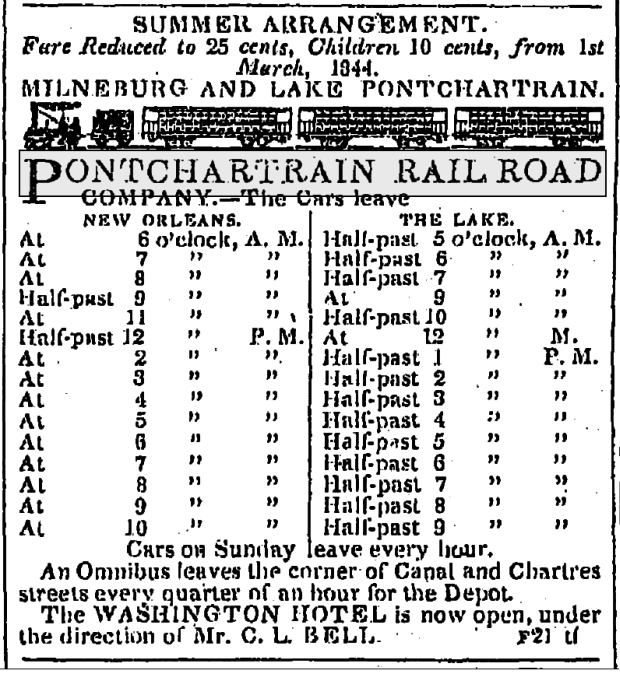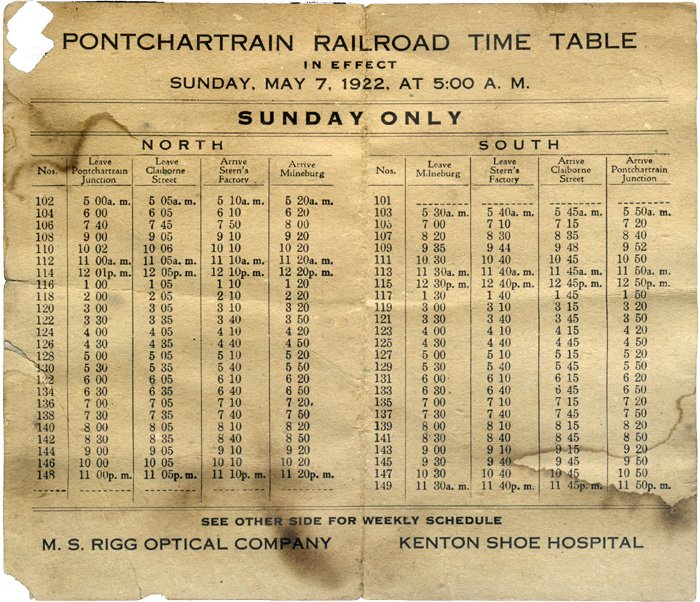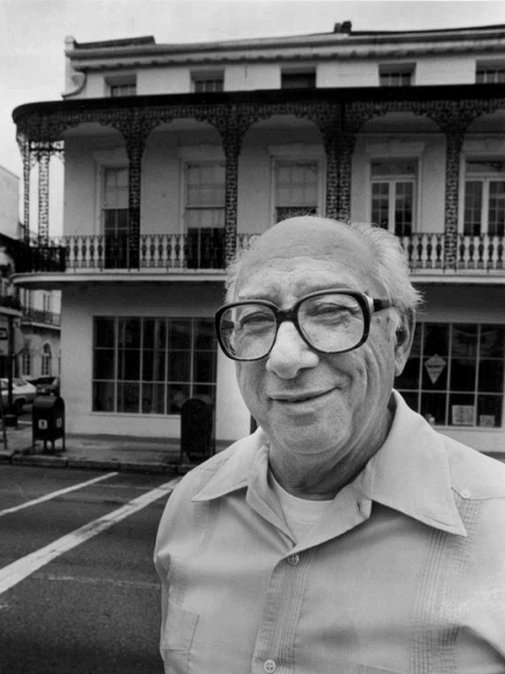|
Today in New Orleans History |
|
|
April 14


 The 1855 matches featuring the horses Lexington and Lecompte was such a renowned event that
Currier & Ives were commissioned to design a print (above) commemorating the race. The center text reads “Celebrated
horse Lexington (5 yrs. old) by "Boston" out of "Alice Carneal": Bred by Dr. Warfield, owned by R. Ten
Broeck, esq. winner of the great 4 mile match for $20,000 against "LeCompte's" time of 7:26. Over the Metairie course.
New Orleans, April 2nd 1855. Won in 7:193/4!!!” (Photo Courtesy of the Library of Congress.) The image on the right shows a closer view of the print’s text regarding a rematch on
Aprile 14, 1855. About the race, Grace King wrote in 1926 “…the grand stand, exclusive as a private ball-room,
glittering with ladies in toilets from the ateliers of the great modistes....and the men, from all over the South glittering
too…the field packed . . and all round about, trees, fences, hedges, tops of carriages, crowded with every male being
that could walk, ride, or drive from the city...— that superb track of old Metairie…A volume would not hold it
all before we even get to Lexington and Lecompte …Alas! The old Metairie is expiating its sins now as a cemetery”.
Metairie Cemetery was included in the National Register of Historical Places in 1991. From Metairie (Images of America) by Catherine Campanella.  

To receive an update for each day in New Orleans
history, join our facebook page
- Today in New Orleans History
In April of 1881 the New Orleans Drainage & Sewage Company was
organized with J. H. Oglesby as president and W. W. Howe as secretary. This corporation negotiated with
the city a contract to perform both of these necessary works. An ordinance approving the proposed arrangement was passed
by the council on April 14, 1881 While this measure was being considered by the mayor, a strong public
sentiment developed against any system which contemplated the underground disposal of sewage as the company proposed. A petition
was sent to the mayor asking him to veto the ordinance because sewer gas would be produced in the mains which would affect
injuriously the health of the community. The soil, argued the petitioners, was of a character to make it impossible to lay
the pipes satisfactorily; grease would collect and choke the mains. The mayor, however, signed the ordinance on April 19,
stating that in his opinion the proposed works were needed, and as the city was not financially able to undertake them itself,
it was necessary to entrust them to private enterprise. The contract with the New Orleans Drainage & Sewage
Company called for the construction of what was somewhat vaguely denominated "the system introduced in Memphis, Tennessee,"
in the preceding year. This, it was understood, had been devised by George B. Waring, who was also to supervise the
work in New Orleans. What was projected may be inferred from a passage in the contract as reproduced in one of the
city newspapers, in which the plan was described as: "To lay drains and sewers not less than •four feet deep, house
connections not less than •two feet deep, watertight for sewage, but not so for drainage, which is intended to pass
off as before in gutters and canals, [. . .] porous undersoil pipes to subsurface drainage; sewage to terminate
at a point to be agreed upon in a receptacle or receptacles, so as to give same facilities as if they discharged into a
natural low outlet, to be pumped into the river. The subsoil water to be pumped into canals at the option of the company.
All city buildings to discharge sewage without charge."It was the intention that operations should begin in the area
bounded by Louisiana Avenue, Enghien Street, Rampart, Carondelet and the river. One-fifth of the work was to be completed
each year until the whole was finished, and then the system was to be extended at the same rate to the other parts of the
city. The city bound itself not to adopt any other project for twenty-five years, but after twenty years it was to enjoy
the right of purchase. As in the case of the Jouet plan, nothing was ever done with this ambitious project. From History of New Orleans by John Kendall, published
by The Lewis Publishing Company, Chicago and New York, 1922
Basin Street Neutral Ground is Named "Garden of the Americas" Much
discussion ensued. On July 12, 1955, Morrison said "We assured the Jazz Foundation [New Orleans Jazz
Club] a few months ago [at the lighting ceremony] there would be a monument to jazz on the street and it is a definite plan
of the city". L.A. Riley wrote, and his letter was published in the paper on July
17, 1955. He recounted personal memories of Milneburg's long pier stretching from the original shore to the lighthouse
with its walkways to many camps and clubhouses where jazz parties were "all conducted by very respectable people. He
contended that while jazz was played on Basin Street it was born in Milneburg and that that Milenburg Joys (not Basin Street
Blues) should be the "New Orleans anthem". Riley suggested that a monument to jazz placed, not on Basin Street but
"where Milneburg once stood at Pontchartrain Beach between the lighthouse and former shoreline. The same day Riley's
letter appeared so did one from Blanchin which stated that the non-profit New Orleans Jazz Club, formed in 1948, supported
Morrison's Basin Street monument site. On July 21, 1955, the editor of the Picayune
opined that a panel of jazz historians could best choose the location and wording for a monument and ended with "Take
it easy", regarding the furor the issue had caused. The following day, William Dane's letter appeared (on July
22, 1955) suggesting that, instead of Bolivar, the statue of assassinated police chief David Hennessy should be
transplanted from Metairie Cemetery. August 1, 1955 brought a letter from J.F.O. who claimed he had played music for 35 years,
thought a monument to jazz was a good idea, and stated "I never heard of Simon Bolivar", which was likely the sentiment
of many other New Orleanians.
Cosimo Matassa is Inducted into the Rock and Roll Hall of Fame Photo from the Louisiana Endowment for the Humanities Born
in New Orleans on April 13, 1926, Cosimo Matassa is the recording
engineer and studio owner responsible for nationally renowned R&B and rock and
roll recordings at his New Orleans studios. Matassa described himself simply as a "sound engineer" in a July 19,
1981 Times-Picayune article written by John Pope. He went on to say that his formula for success was not complicated
in any way..."Do it live or do it over again until it was done right". He did it right for hundreds of young
unknown musicians including Ray Charles, Fats Domino, Mac Rebbenack (Dr. John), Mickey Gilly and so many more from 1945 through
1968 in his studio in the Quarter and later in the Central Business District. J&M recorded Alan Toussaint's first
record, "The Wild Side of New Orleans" which was released by RCA Victor. He recorded Aaron Neville's "Tell
it Like it Is", Robert Parker's "Barefootin'", and Little Richard's "Tutti Frutti" in 1956 -- a recording
which has been acclaimed as a seminal Rock and Roll song. Cosimo Matassa was an 18 year-old second-year
chemistry major at Tulane during World War II who quit school because he thought he would be drafted into military service.
But the war soon ended and he drifted into the music industry by taking a job involvling juke boxes which led to an interest
in records which led to invlovement with his father's J&M Music Shop on the corner of Rampart and Dumaine which evolved
into his first studio in 1945 in a back room of the store which was named for his dad, John Matassa and his partner
Joe Mancuso. In 1955, Cosimo moved to the larger Cosimo Recording Studio in the CBD.
Here, as engineer and proprietor, he was crucial to the development of the R&B, rock and soul sound of the 1950s and
1960s, often working with producers Dave Bartholomew and Allen Toussaint. He recorded hits by Fats Domino’s "The
Fat Man" (another contender for the first rock and roll record), Little Richard's "Tutti
Frutti", and records by Ray Charles, Lee Dorsey, Dr John, Smiley Lewis, Bobby Mitchell,
Tommy Ridgley, the Spiders and many others. He was responsible for developing what became known as the "New Orleans
Sound", with strong drums, heavy guitar and bass, heavy piano, light horn sound and a strong vocal
lead. In the late 1950s and early 1960s, Matassa also managed the successful white New Orleans rock and roll performer Jimmy
Clanton. He retired from the music business
in the 1980s to manage the family's food store, Matassa's Market in the French Quarter. In December 1999, J&M Recording
Studio was designated as an historic landmark by the Orleans Parish Landmarks Commission.
In October 2007, Matassa was honored for his contributions to Louisiana music with induction into The Louisiana Music Hall
of Fame. On September 24, 2010, the Rock and Roll Hall of Fame and Museum designated Cosimo
Matassa’s original J&M Recording Studio as an historic Rock and Roll Landmark, one of 11 nationwide. The studio
is now a laundromat. Matassa was inducted into the Rock and Roll Hall of Fame during its 27th
annual ceremony on April 14, 2012. In 2013, he was inducted to the Blues Hall of Fame. |
|
|

To receive an update for each day in New Orleans history,
join our facebook page - Today in New
Orleans History.
Analytics |
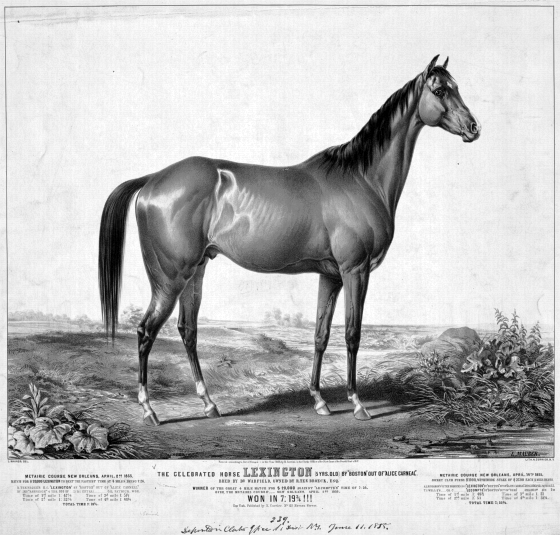
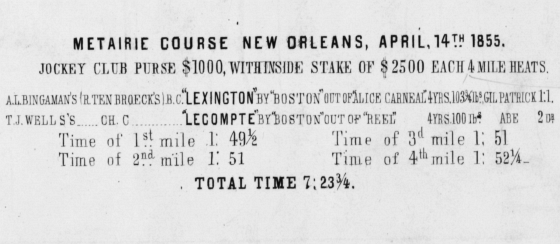
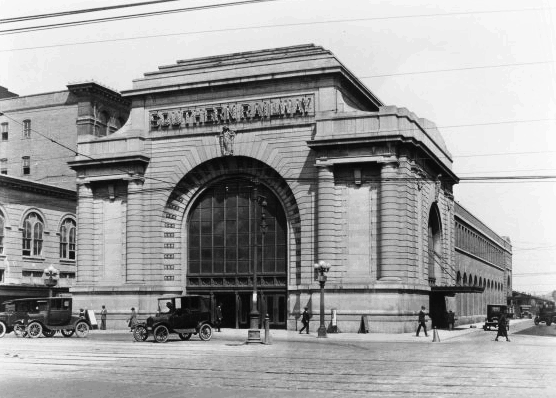 Mayor deLesseps S. Morrison's vision for New Orleans was one of a modernistic 'prgressive' hub of business activity.
He saw other cities grow by leaps and bounds after tearing down the old and bringing in the new and he envisioned the same
for our town. Morrison's administration changed the footprint of New Orleans irrevocably. One example was the demolition
of the Southern Railroad Terminal, also known as the Terminal Station, which was constructed at 1125 Canal at Basin Street
in 1908. The building was designed by Daniel Burnham, the architect for Washington D.C.'s Union Station.
Mayor deLesseps S. Morrison's vision for New Orleans was one of a modernistic 'prgressive' hub of business activity.
He saw other cities grow by leaps and bounds after tearing down the old and bringing in the new and he envisioned the same
for our town. Morrison's administration changed the footprint of New Orleans irrevocably. One example was the demolition
of the Southern Railroad Terminal, also known as the Terminal Station, which was constructed at 1125 Canal at Basin Street
in 1908. The building was designed by Daniel Burnham, the architect for Washington D.C.'s Union Station. 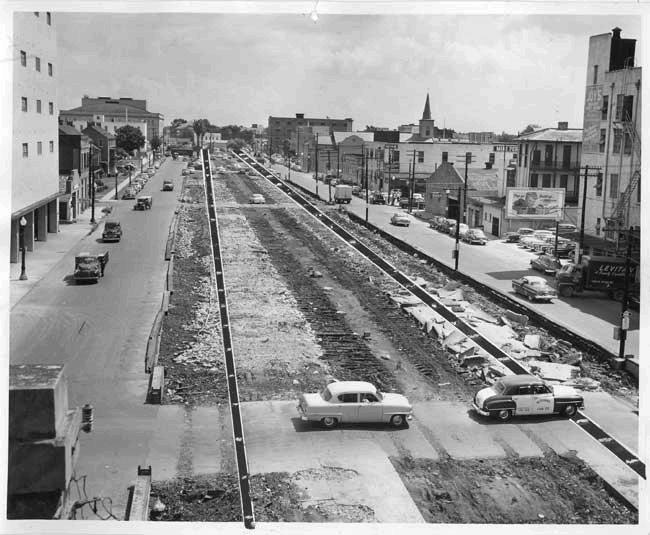
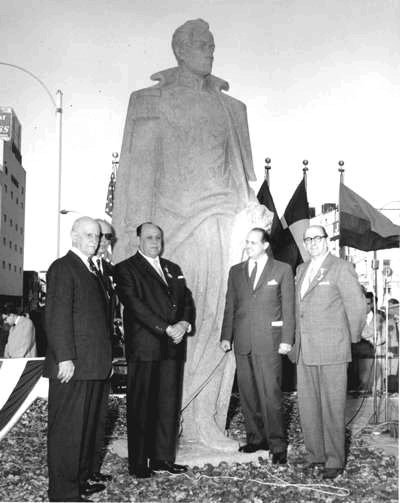
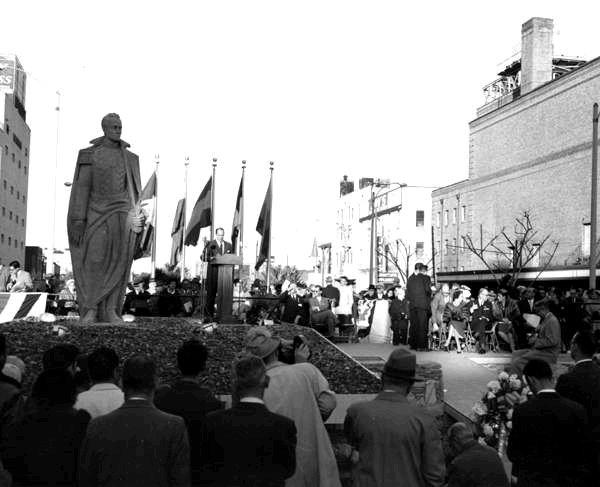 Despite the hoopla, the name for Basin Street's neutral ground as "Garden of the Americas" was officially adopted
via a city ordinance on April 14, 1957. On Monday, May 6, 1957, a "Parade of Progress" ambled 22
blocks from the Municipal Auditorium to Basin Street at Canal where ground was broken for the plaza that would contain Simon
Bolivar's giant likeness. The Tulane band played for guests from South and Central America. The first shovel of dirt
was turned by Francisco Pacanins, Consul General of Venezuela, whose country provided $350.00 for the monument. The
parade then proceeded to the New City Hall which officially opened that day. And finally, on Monday November 25, 1957,
the seven-ton, 12 foot-tall, granite statue of Simon Bolivar was unveiled. on the Basin Street neutral ground.
Despite the hoopla, the name for Basin Street's neutral ground as "Garden of the Americas" was officially adopted
via a city ordinance on April 14, 1957. On Monday, May 6, 1957, a "Parade of Progress" ambled 22
blocks from the Municipal Auditorium to Basin Street at Canal where ground was broken for the plaza that would contain Simon
Bolivar's giant likeness. The Tulane band played for guests from South and Central America. The first shovel of dirt
was turned by Francisco Pacanins, Consul General of Venezuela, whose country provided $350.00 for the monument. The
parade then proceeded to the New City Hall which officially opened that day. And finally, on Monday November 25, 1957,
the seven-ton, 12 foot-tall, granite statue of Simon Bolivar was unveiled. on the Basin Street neutral ground. 